Magento - Quick Guide
Magento - Overview
What is E-commerce?
E-commerce (Electronic Commerce) is a type of business that involves the commercial transaction or purchasing or selling of goods and services through electronic channels known as internet. It was first introduced in the year 1960 through EDI (Electronic Data Interchange) on VAN (Value-added network). Using E-commerce, you can sell physical products or services (where the payment is made online).
Following are the categories of E-commerce −
B2B (Business to Business) − This transaction is between businesses. It is between the wholesaler and the retailer or between the manufacturer and the wholesaler.
B2C (Business to Consumer) − This transaction is between businesses and consumers. In this type of transaction, merchants sell products to consumers through shopping cart software.
C2C (Consumer to Consumer) − In this type of transaction, one consumer or customer interacts with other consumers through internet.
C2B (Consumer to Business) − This transaction is between the consumer or the customer and businesses or organizations where the consumer makes a product that the organization uses it to complete the business.
What is Magento?
Magento is an open source E-commerce software, created by Varien Inc., which is useful for online business. It has a flexible modular architecture. It is scalable and it has many control options that helps the user to build both user-friendly and search engine friendly websites.
Magento uses E-commerce platform which offers companies the ultimate E-commerce solutions and extensive support network. Magento allows user to update E-commerce website automatically. It is simple, quick and versatile to use.
Magento was developed by Varien Inc., and it was first released on March 31, 2008.
Why to Use Magento?
Magento is an open source E-commerce software.
Magento is scalable and offers small organizations to build business.
Magento enables searching and sorting of products in several ways.
Magento easily integrates with many of the third-party sites which are needed to run effective E-commerce website.
Features
Magento provides different payment methods such as credit cards, PayPal, cheques, money order, Google checkouts, etc.
Magento enables shipping of products in one order to multiple addresses.
Magento helps to manage the orders easily by using the admin panel.
Magento provides order of product status and history of product. It also supports e-mail and RSS feeds.
Magento supports multiple languages, different currencies and tax rates.
Magento filters the products and displays in grid or list format.
Magento makes it easy to browse the products. It has features such as image zoom-in and checking of stock availability.
Magento has built-in SEO (Search Engine Optimization).
Advantages
Magento is user friendly E-commerce software.
Magento is compatible with smartphones, tablets and other mobile devices.
Magento provides multiple payment options, so every visitor can make payment based on their preferred payment gateway.
Magento has many extensions which support the development of an online store.
Disadvantages
Magento uses larger disk space and memory.
Magento takes longer time to build the customized functionality.
Magento is very slow compared to other E-commerce sites.
Magento needs proper hosting environment. If the hosting environment is improper, the user can face many problems.
Magento - Installation
This chapter provides step-by-step procedure for Magento installation. Before installing Magento, you require the following system requirements.
System Requirements for Magento
Database − MySQL 5.1 +
Web Server −
Operating System − Cross-platform
Browser Support − IE (Internet Explorer 7), Firefox, Google chrome
SSL (Secure Socket Layer) − A valid security certificate is required for HTTPS
PHP Compatibility − PHP 5.4+
Download Magento
Step 1 − Open the link https://www.magentocommerce.com/products/downloads/magento/, you will get to see the following screen −

Step 2 − Click on the dropdown menu, the archive file is available in .zip, .tar.gz and .tar.bz2 for downloading.
Step 3 − Extract the Magento web files from the archive on your computer and upload it into your web server or localhost.
Step 4 − Magento requires MySQL database. So create a new empty database and user/password (for e.g. user as "root" and password as "root" or else you can set as per your convenience) for Magento.
Step 5 − Open your browser and navigate to your Magento file path (for e.g. http://localhost/magento) to start your Magento installation. Then you will get a screen of the Magento installer as shown in the following screenshot.
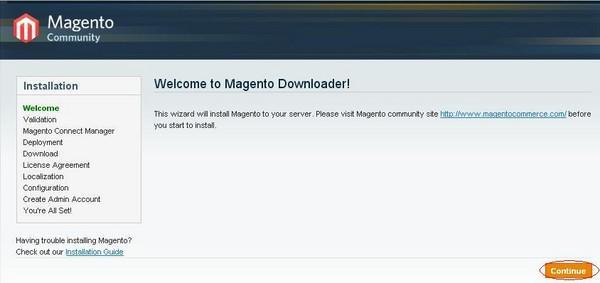
Step 6 − Click on Continue button and you will get Validation for Magento Downloader screen as shown in the following screen.

Here, enter the database details, if you want to check for InnoDB support for Magento. Otherwise, click on Continue button to proceed to the next step.
Step 7 − Next, you will get Magento Connect Manager Deployment screen.

It gives protocol name (HTTP or FTP), stability version such as stable, beta, alpha and deployment type. Select proper options and click on the Continue button. It will start the downloading process for Magento.
Step 8 − Magento's Installation Wizard screen pops up. Check the I agree to the above terms and conditions checkbox and click on the Continue button.

Step 9 − Next you will get the Localization screen for selecting the Locale, Time Zone and Currency as shown in the following screen.

Select proper locale name, time zone and currency and click on the Continue button.
Step 10 − The next screen that pops up is the Configuration screen.

Fill the database information such as Database Type, Host, Database Name, User Name and User Password. If you do not want to validate the Base URL, then tick the Skip Base URL validation before Next Step checkbox and click on the Continue button.
In case the http://localhost/magento doesn't work, use this as base url instead- http://127.0.0.1/magento
This step will take some time as Magento will be creating the Database Tables.
Step 11 − Now, go to the Create Admin Account screen.

Here enter your personal information such as First Name, Last Name and Email and the Login Information such as Username, Password and Confirm Password for admin to use in backend. Need not worry about Encryption Key field as Magento will generate a key on the next page. After filling all information, click on the Continue button.
Step 12 − Copy the encryption key, which will be used to encrypt passwords, credit cards and other confidential information. Then you can select Frontend or Backend of new Magento website.
Step 13 − After successful installation of Magento, click on the Go to Backend button to login to admin panel.

Step 14 − After logging in, you will get the Dashboard of Admin panel as shown in the following screen.

Magento - Architecture
In this chapter, we are going to discuss the architectural style of Magento, for implementing user interfaces. The following diagram shows the architecture of Magento −

The Magento architecture comes with Models, Views and Controllers.
User Request − The user sends a request to a server in the form of request message where web browsers, search engines, etc. act like clients.
View − View represents the data in particular format. It is the user interface which is responsible for displaying the response for user request. It specifies an idea behind the presentation of the model's data to the user. Views are used to reflect "how your data should look like".
Controller − The controller is responsible for responding to user input and perform interactions on the data model objects. It uses models to process the data and send responses back to the view.
Model − The model is responsible for managing the data of the application. It contains logic of the data and represents basic data object in the framework. It responds to request from the view and to the instructions from the controller to update itself.
Database − Database contains the information which is requested from the user. When the user requests data, view sends requests to the controller, the controller requests from the model and the model fetches the required information from the database and responds to the user.
WSDL − WSDL stands for Web Services Description Language. It is used for describing web services and how to access them.
Magento - Product Overview
Magento Products
Products are the items or things that are sold in Magento. Product can be anything that is capable of satisfying the customer’s needs. This includes both physical products and services.
Product Types
Magento provides 6 different types of products. Appropriate selection of product type is essential for accessing the appropriate set of features required to sell the product. Following are the product types available in Magento.
Simple Products
Grouped Products
Configurable Products
Virtual Products
Bundled Products
Downloadable Products
Simple Products
These are general product type, which are the most used products. In this section, there are no options for selecting size or color of the product.
Example − Coffee cup, DVD's, Camera lens, etc.
Grouped Products
This is a group of simple products. In this type, you cannot specify a specific price for a product; you can just specify the discount.
Example − Cell phone + Memory card + Ear phone
Configurable Products
In this type, customer can select products according to their color and size before purchasing.
Example − Cell phones obtained in different colors and sizes.
Virtual Products
Virtual products are those which do not have physical counterpart, i.e. these are used for virtual items. These products cannot be shipped or stocked.
Example − Online training course
Bundled Products
Bundled products are those products which cannot be sold separately and doesn't give any choice to the end user.
Example − Consider you want to buy a cell phone which includes earphone, memory card, battery, charging cable, etc. These are together called bundled products. These products cannot be sold individually but can be sold within the bundle product.
Downloadable Products
Products which are available for download are known as downloadable products.
Example − MP3 file, ebook, documents, etc.
Product Attributes
Attribute describes the property of the product. Product attributes helps to set product properties such as color, size width, height, etc. and makes the product unique. You can add as many attributes to your product as required.
The following steps describe, how to set up the attributes for products in Magento −
Step 1 − Login to your Magento Admin Panel.
Step 2 − Go to Catalog and select Attributes from the dropdown menu and click on the Manage Attributes option.
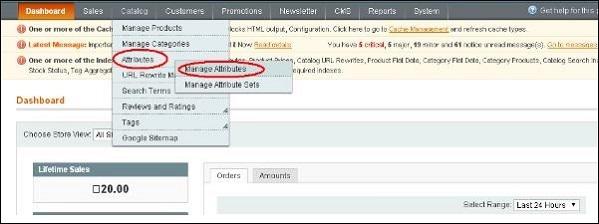
Step 3 − Under Manage Attributes section, you will find different attributes used in the system. For adding new attribute, click on Add New Attribute seen on the top right corner of the screen.

Step 4 − Now you need to set the attribute properties for your product. After setting up all the required attribute properties, click on Save Attribute button to store the product information.

Magento - Setup Languages
In this chapter, we will see how to use the Multilanguage feature of Magento.
Step 1 − Go to the official website of Magento and search for a new language pack using search field. For instance, if you want to search for Italian language, type Italian Language Pack in search box and press enter. It displays the installation package file. Click on it.

Step 2 − You get a package for installing language. You must login to the site to get a language pack. After you login, you get the Extension Key as shown in the following screen.

Step 3 − Now login to your Magento Admin Panel and go to the System → Magento Connect → Magento Connect Manager option.

Step 4 − It again asks you to login. Enter your credentials to redirect to Magento Connect Manager window.
Step 5 − Now under Extensions section, paste the Extension Key (that you had already copied in step 2) and click on Install button. It then displays a status as "Ready to install" and click on Proceed button to install the language.

Step 6 − It checks for dependencies of packages and displays the message as Cache cleaned successfully. Now go to admin dashboard page by clicking on Return to Admin link.

Step 7 − Go to the System menu and click on Manage Stores option.

Step 8 − You will get Manage Stores section to create store view as shown in the following screen.

Step 9 − Click on Create Store View button and enter the information for Store, Name, Code, Status and Sort Order fields and click on Save Store View button to store the view as shown in the following screen.

Step 10 − To set up your stored language pack, go to the System menu and click on the Configuration option.

Step 11 − Go to Current Configuration Scope section on the left side of the page and select the Italian option from the dropdown menu.

Step 12 − Now under General section, click on Locale Options, uncheck the Use Website checkbox, select the Italian (Italy) option from the dropdown menu of Locale field and click on Save Config button.

This saves your language in Magento and selected langauge will be assigned in the selected store view.
Magento - Setup Contact
Magento has built-in contact form which can be used for general contacts and can be found in the footer part of your Magento installation.
Following are the steps to create contact form in Magento −
Step 1 − Login to your Magento Admin Panel.
Step 2 − Go to CMS menu and click on the Pages option.

Step 3 − Select the page which you would like to edit or else you can create the new page by clicking on Add New Page button.

Step 4 − Click on the Content option on the left side of page which will open the WYSIWYG editor and click on the HTML option that display HTML Source Editor window and paste the below code.
<!- CONTACT FORM- >
{{block type = "core/template" name = "contactForm"
form_action = "/contacts/index/post" template = "contacts/form.phtml"}}
<!- END OF CONTACT FORM- >
Step 5 − Click on Save Page button and preview the created page to see the contact form.

Magento - Setup Categories
Categories are classes or things which are related, and have some shared characteristics. The following steps describe how to add categories for the products in Magento.
Step 1 − Login to your Magento Admin Panel.
Step 2 − Go to the Catalog menu and click on the Manage Categories option.

Step 3 − Next you need to fill the fields like Name of the category, Is Active status which is set to Yes/No and Description of the category.

Step 4 − Click on Save Category button and your category is ready to have the products added to it.
Magento - Setup Products
Products are the items or things that are sold in Magento. You can add your products to the store view as per customers’ needs. It includes both physical products and services.
Magento provides an easy way to add your product quantities as described in the following steps −
Step 1 − Login to your Magento Admin Panel.
Step 2 − Go to Catalog and select the Manage Products option from dropdown menu.

Step 3 − Under Manage Products section, you will see a list of products, if you have added to your Magento store. If you want to add new product, click on the Add Product button on the page.

Step 4 − Next select the Attribute Set and Product Type. There is no need to change anything just go ahead and click on Continue button.

Step 5 − Under General section, fill all the details such as Name of the product, Description, SKU (Stock Keeping Unit), Weight, Status, Visibility etc, and then click on the Save and Continue Edit button.
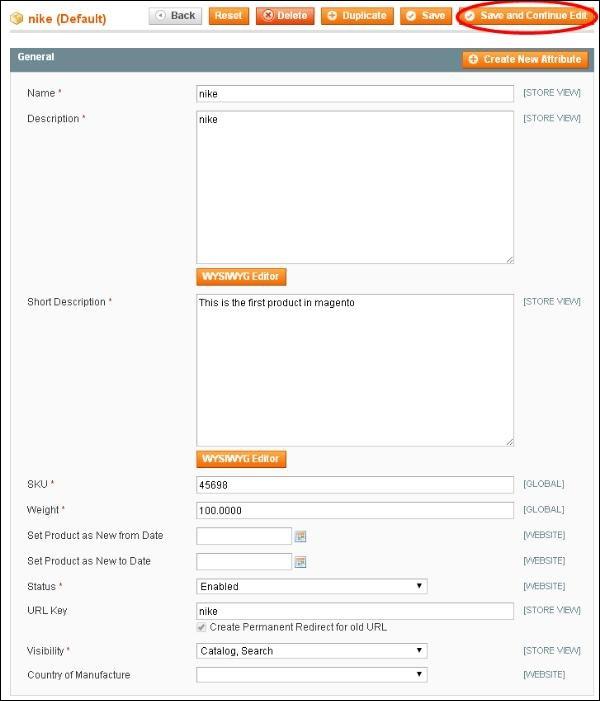
Step 6 − Enter the Price and Tax Class for your product and you can also add additional price using Group Price, Special Price and Tier Price options. Fill all the necessary fields and click on Save and Continue Edit button to proceed further.

Step 7 − If you want to see list of the saved products, just go to the Catalog and click on the Manage Products option.

Step 8 − You can customize the product information by clicking on the Inventory option on the left side. You can set quantity of the products, stock availability, etc as shown in the screen. Then save the product by clicking on save button.

Magento - Setup Inventory
Inventory allows setting a product's stock quantity. For instance, you have a product with 100 units in stock. If you set the stock availability to "Out of Stock" then it will force the item to be out of stock. We will see how to configure and manage the inventory settings in Magento.
Step 1 − Login to your Magento Admin Panel.
Step 2 − Go to System menu and click on the Configuration option.

Step 3 − Click on the Inventory option under the Catalog section on the left side of the screen which contains two panels Stock Options and Product Stock Options as shown in the following screen.

Step 4 − The Stock Options panel pops up which contains some settings.

Set Items' Status to be In Stock When Order is Cancelled − It displays the status of the item in the stock when order is cancelled. By default, it is set to Yes.
Decrease Stock When Order is Placed − It indicates whether the stock quantity of the product should be reduced when an order is placed. By default, it is set to Yes, meaning it decreases the stock of the products when an order is placed.
Display Out of Stock Products − As the name suggests, it displays the products which are out of stock. By default, stock products are not shown in the catalog. If you want the product to be visible to the customer, then set it to Yes.
Only X left Threshold − It is used to set threshold number. When the units of that product have dropped to that number, it will display Only X left message on the product details page. By default, it is set to 0 which means it is disabled.
Display products availability in stock in the frontend − It displays the availability of stock products by setting it to Yes option.
Step 5 − Product Stock Options panel contains settings related to managing the stock of the products.

Manage Stock − By default, it is set to Yes which means it specifies the number of products per unit and it decreases the stock of the products when an order is placed.
Backorders − By default, it is set to No Backorders option. If it is enabled, customers can buy products even if they are out of stock. If you want to allow backorders, then set this option to Allow Qty Below 0 (customers are able to backorder the products) or Allow Qty Below 0 and Notify Customer (customers can backorder the products which will be notified on the shopping cart page of the frontend).
Maximum Qty Allowed in Shopping Cart − It is used to set the maximum number of units per product that customer can order. This means customers can order the maximum allowed quantity from certain product. By default, it's set to 10000.
Minimum Qty Allowed in Shopping Cart − It is used to set the minimum number of units per product that the customer is required to purchase.
Qty for Item's Status to Become Out of Stock − It displays the message as "Out of Stock", when the quantity of the product becomes zero.
Notify for Quantity Below − By default, it is set to 1 which notifies when stock of the product reaches one. If you enter 0, it will disable the option. You will be informing with RSS feeds. To do this, you need to go to Catalog menu > Manage Products and click on the link Notify Low Stock RSS as shown in the following screen.

When you click on the link, it will ask for admin username and password.
Enable Qty Increments − By default, this option is disabled. If you set this option to Yes, a field labeled Qty Increments will appear just under it. You can type the number of products that make up a quantity increment.
Automatically Return Credit Memo Item to Stock − By default the products in the order are not returned to stock. If you want items from orders that you refund to be returned to stock, set the option to Yes.
Fill all information in the respective fields and click on the Save Config button.
Magento - Setup Taxes
Magento allows to set up different tax classes and tax rates, and bringing them together into tax rules. You can also define product tax classes and assign them to products. Tax rules are combination of product tax class, customer tax class, tax rates, shipping address and amount of purchase.
The following steps describe how to add and manage tax classes in Magento.
Step 1 − Login to your Magento admin panel.
Step 2 − Go to Sales menu → Tax and click on the Product Tax Classes option.

Step 3 − Product class is a type of product that is being purchased. It includes two product tax classes:Taxable Goods and Shipping. To add new product tax class, click on Add New button as shown in the following screen.

Step 4 − Now enter the name for your product tax class in the Class Name box and click on the Save Class button on the upper right corner.

Set Up Tax Rates
Tax rate is a combination of tax zone (such as country, state or zip) and percentage. You can set up tax rates as shown in the following steps.
Step 1 − Login to Magento Admin Panel.
Step 2 − Go to Sales menu → Tax and click on the Manage Tax Zones & Rates option.

Step 3 − Under Manage Tax Rates window, click on the Add New Tax Rate button.

Step 4 − It provides several options such as −
Tax Identifier field defines the title of the newly created tax rate.
Country and State fields describes the country and state to which the specific tax applies. You can select country and state from the dropdown options given.
Zip/Post is range (set to Yes) field which provides two fields, i.e. Range From and Range To. These fields show the starting and ending of ZIP code range.
Rate Percent specifies the percent of the tax rate.
After completing the settings, click on the Save Rate button.

Set Up Tax Rules
Tax rules are entities that combine product tax classes, customer tax classes and tax rates. Without setting up tax rules, taxes will not be applied. It determines how tax will be applied on each order that is placed in the store.
The following steps describe how to add tax rules for products in Magento −
Step 1 − Login to your Magento Admin Panel.
Step 2 − Go to Sales menu → Tax and click on the Manage Tax Rules option.

Step 3 − To add new tax rule, click on the Add New Tax Rule button in the top right corner.

Step 4 − It contains some settings such as −
Name field specifies name for tax rule
Customer Tax Class field displays the list of customer tax classes that you have created
Product Tax Class field displays the list of product tax classes that you have created
Tax Rate field selects the tax rate which you want to apply to this rule
Priority field specifies when the tax should be applied to other tax rules
Sort Order field displays the order in which tax rules should be displayed
After completing the settings, click on the Save Rule button.

Import/Export Tax Rates
Magento provides support for exporting and importing tax rates to the webstore. You can set up different tax percentages settings per different zip code. You can edit the rates in excel and import them back.
The following steps describe how to Import/Export tax rates in Magento −
Step 1 − Login to your Magento Admin Panel.
Step 2 − Go to Sales menu → Tax and click on the Import/Export Tax Rates option.

Step 3 − It will display the window as shown in the following screen.
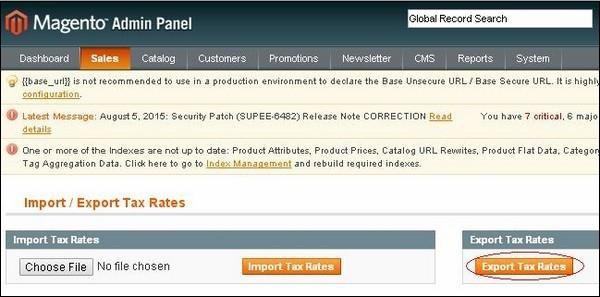
Step 4 − When you click on the Export Tax Rates button, it will download the file as shown in the following screen.

The spreadsheet includes Code, Country, State, Zip/Post Code, Rate, Zip/Post is Range, Range From, Range To and Default columns. For instance, while installing Magento, there is one tax rate for the New York. The US-NY-*-Rate 1 means tax rate number 1 for New York which is 8.375 percent.
Step 5 − You can edit the file and import the tax rates into your Magento store by going to Sales menu → Tax and click on the Import/Export Tax Rates option.

Click on the Choose File button to locate the CSV file from your computer and click the Import Tax Rates button.
Step 6 − On the Admin menu, go to Sales menu → Tax and click on the Manage Tax Zones & Rates option. The imported data appears as shown in the following screen.

Magento - Setup Shipping Rates
In online business, selling of physical products to customers should have flexible and scalable shipping policies. Magento is a friendly system for business needs including shipment rates.
The following steps describe how to setup shipping rates in Magento −
Step 1 − Login to your Magento Admin Panel.
Step 2 − Go to the System menu and click on the Configuration option.

Step 3 − On the left side of the navigation bar, click on the Shipping Methods under Sales section.

Step 4 − Then expand the Table Rates section, enable the table rates by selecting Yes from the dropdown menu for the Enabled field. It will turn off flat rate shipping and allow you to specify different rates based on chosen criteria.
Step 5 − Fill all the required fields as shown in the following screen and click on the Save Config button. It will save your current configuration into Magento.

Step 6 − If you want to modify the fields of table rates section, go to Current Configuration Scope menu in the top left corner and select the Main Website option from dropdown menu.

Step 7 − Magento allows to view or generate and download different reports. Magento has integrated tools for CSV files generation. You can create the shipping rates in a spreadsheet and then import them to your website. Click on the Export CSV button to download the template. Upload the file into Magento by clicking on the Choose File button next to the import option.
Step 8 − After uploading the file, click on the Save Config button on the top right corner to save the table rates.

Step 9 − The CSV structure will look like as shown in the following screen −

The first column specifies the country where the shipping rate will apply, second column specifies the region/state within that country, third column specifies the postal code of the region/state, fourth and fifth columns determine the price for the shipping rate in which these values represent whatever currency you have set for your webstore.
After completing this process, save the file and import it into your Magento webstore by using the Import button.
Magento - Setup Payment Plans
PayPal is a secure way for customers to pay online. This chapter explains how to set up payment methods in Magento. With PayPal and Magento, you can accept payments from credit cards, debit cards and PayPal account holders.
The following steps describe how to set up payments plans in Magento −
Step 1 − Login to your Magento Admin Panel.
Step 2 − Go to System menu and click on the Configuration option.

Step 3 − On the left side of the navigation bar, click on the Payment Methods under Sales section.

In some of the payment methods, there are some common settings as specified −
Enabled − This option is used to enable or disable the payment method.
Title − It specifies the title for the payment method which will display during customer checkout and inside order e-mails and summaries.
New Order Status − It represents the status of an order after processing of payment. It will display either Pending or Processing choices.
Sort Order − During checkout mechanism, it displays the position of the payment method in the list of all the payment choices.
Payment Applicable From − It selects payment from all or some specific countries in which countries will offer the payment method you are configuring.
Minimum Order Total − It specifies minimum order amount available for the products order.
Maximum Order Total − It specifies maximum order amount available for the products order.
Step 4 − Next, under Merchant Location panel, set the merchant country from the dropdown menu.

Step 5 − It provides following types of payment methods which adds PayPal as additional payment method to your checkout page.

Step 6 − You can click on the Configure button to make PayPal settings. Fill the e-mail field with e-mail address which is associated with PayPal merchant account for accepting the payments and along with all other required fields.

Step 7 − The following screen shows you the Basic and Advanced settings of PayPal payments.

Step 8 − Under Basic Settings, enter Title for the payment method, Sort Order option used to sort payment methods in the checkout page, Payment Action section offers to select either Sale or Authorization or Order which defines how the payment will be processed in the PayPal payment system. Under Advanced Settings, select the Payment Applicable From option as All Allowed Countries and similarly fill all other required fields.
Step 9 − Next panel is Saved CC which provides credit card payments on your website.

Credit Card Types − It allows for selecting credit card types for the payment processing.
Request Card Security Code − It asks for the credit card's security code which makes fraud little harder by setting it to Yes.
3D Secure Card Validation − It is an additional security functionality where customer needs to provide credit card password to complete the purchase order.
Step 10 − Next is the Check/Money Order panel.

Set the values for Make Check Payable to and Send Check to options.
Step 11 − The Zero Subtotal Checkout panel is a payment option that displays when order total is zero and not required to enter payment details for the customer.

Step 12 − The Bank Transfer Payment panel contains one specific field called instructions which allows to enter bank account details that customer needs to transfer money to you.

Step 13 − The Cash on Delivery Payment panel also contains one specific field called instructions which allows to list information related to the cash on delivery payment.

Step 14 − The Purchase Order panel contains same options.

Step 15 − The Authorize.net Direct Post panel contains some other options such as setting the payment action, API login ID for authorization, setting the transaction key and merchant name, setting the test mode to Yes/No, Gateway URL of authorization, setting the accepting currency, e-mail of customer and merchant, types of credit card used for purchase, enable or disable the credit card verification as shown in the following screen.

Step 16 − The Authorize.net panel works as similar to the Authorize.net Direct Post panel, with the only difference being it allows to enable or disable the 3D secure card validation on the credit cards, which makes fraud little harder by setting it to Yes.

Step 17 − After you are done with the settings, click on the Save Config button on the top right corner of the page to save your payment methods.

Magento - Setup Payment Gateway
Payment gateway processes the credit card data securely between the customer and the merchant and also between the merchant and the payment processor. It is like a checkpoint that protects against attempting to gather personal and financial information from customers and also acts as a mediator between the merchant and the sponsoring bank.
The following steps describe how to setup payment gateway in Magento −
Step 1 − Login to your Magento Admin Panel.
Step 2 − Go to System menu and click on the Configuration option.

Step 3 − Next you will see some list of options on the left side of the page. Scroll down and go to the Sales section and click on the Payment Methods option.

Step 4 − Under the Payment Methods section, expand the PayPal Payment Gateways option. It provides two types of payment gateway methods; one is Payflow Pro (Includes Express Checkout) and Payflow Link (Includes Express Checkout). Click on the Configure button to enter details for Payflow Pro and Payflow Link options respectively.

The Payflow Pro option is a customizable payment gateway, which can be used with merchant account to process credit card transactions. It does not need PayPal account as they can enter their credit card information directly on site and you need to add API credentials in Magento admin panel. It is also used to process PayPal Express Checkout (it allows customers to pay by credit card or from the security of their personal PayPal accounts) transactions.
Under Payflow Link option, once the customer decides to checkout, the checkout process is carried out on PayPal site. It is often called as hosted payment gateway that keeps the customer on your site by providing fast and easy way to add transaction processing to your site.
Magento - Setup Payment Methods
This article explains how to set up payment methods in Magento and also shows how to configure Magento to use PayPal as payment processor for both credit cards and PayPal payments.
The following steps describe how to set up payments in Magento −
Step 1 − Login to your Magento Admin Panel.
Step 2 − Go to System menu and click on the Configuration option.

Step 3 − Next, you will see some list of options on the left side of the page. Scroll down and go to the Sales section and click on the Payment Methods option.

Step 4 − Next, under Merchant Location panel, set the merchant country from the dropdown menu.

Step 5 − It provides following types of payment methods which adds PayPal as additional payment method to your checkout page.

Step 6 − You can click on the Configure button to make PayPal settings. Fill the e-mail field with e-mail address which is associated with PayPal Merchant Account for accepting the payments. Similarly, fill other required fields.

Step 7 − The following screen shows the Basic and Advanced settings of PayPal payments.

Step 8 − Under Basic Settings, enter Title for the payment method. Sort Order option is used to sort payment methods in the checkout page. Payment Action section offers to select either Sale or Authorization or Order, which defines how the payment will be processed in the PayPal payment system.
Step 9 − Under Advanced Settings, select the Payment Applicable From option as All Allowed Countries, Debug Mode option as No, Enable SSL verification as Yes and Transfer Cart Line Items as Yes.
Step 10 − After you are done with the settings, click on the Save Config button on the top right corner to save your payment methods. Now you are ready to accept payments through your shopping cart.

Magento - Setup Currencies
Magento has built-in functionality for currencies. After installing Magento, by default there will be one currency used for pricing and payment.
The following steps illustrate how to set up currencies in Magento store −
Step 1 − Login to your Magento Admin Panel
Step 2 − Go to System menu and click on the Configuration option.

Step 3 − On the left side of the navigation bar, click on the Currency Setup option under General section.

Step 4 − Expand the Currency Options panel, and you will get some settings option.

Base Currency − Select the base currency from dropdown menu that you want to set as default. It is directly associated with the price of the products. If you change the base currency, the price will not change and it won't recalculate using new base currency.
Default Display Currency − It displays the default currency that can be used to show the prices of the products. When customer visits your store, it displays the currency set by you.
Allowed Currencies − It provides a long list which allows you to select more than one currency. If there is more than one currency, then customers can select one of the allowed currencies from the dropdown menu on the frontend.
After selecting your currencies option, click on Save Config button on the top right corner to save your settings.
Magento - Setup Check Out Options
Checkout options are used for enabling and disabling the one-page checkout. This chapter guides you how to configure checkout options from the admin panel of Magento.
Step 1 − Login to your Magento Admin Panel.
Step 2 − Go to System menu and click on the Configuration option.

Step 3 − Under Sales section on the left side of the navigation bar, click on the Checkout option.

Step 4 − Expand the Checkout Options panel which includes setting for one-page checkout with enable/disable option, you can also enable/disable guest checkout and last option from which you can enable or disable terms and conditions.

Step 5 − The Shopping Cart panel has options such as −
Quote Lifetime (days) which determines lifetime of products in cart, after a customer puts items in the cart
After Adding a Product Redirect to Shopping Cart determines whether customers should be redirected to the shopping cart page after the product is placed in the cart.
Grouped Product Image and Configurable Product Image options determine whether the parent image of product should be displayed on the cart and whether configurable product added to the cart should be displayed on the shopping cart or not.

Step 6 − The My Cart Link panel specifies whether the number of quantities in the cart should be shown or whether the number of different products should be shown using the Display Cart Summary field.

Step 7 − The Shopping Cart Sidebar panel contains two options −

Step 8 − The Payment Failed Emails panel has some settings such as −
Payment Failed Email Reciever option stores e-mail address to which payment failed e-mail should be sent.
Payment Failed Email Sender option specify from which e-mail address payment failed e-mail should be sent.
Payment Failed Template option specifies which template should be used to display message.
Send Payment Failed Email Copy To option allows to send copies of e-mails to additional e-mail addresses and last option.
Send Payment Failed Email Copy Method selects either separate e-mails or blind carbon copies methods to send payment failed e-mails.

Step 9 − After done with all settings, click on the Save Config button to save your settings.
Magento - Setup Paypal Payment
In this chapter, we will study how to set up PayPal payment. Following are the steps to set up PayPal payment in Magento.
Step 1 − Login to your Magento Admin Panel.
Step 2 − Go to System menu and click on the Configuration option.

Step 3 − On the left side of the navigation bar, click on the Payment Methods under Sales section.

Step 4 − Next, under Merchant Location panel, set the merchant country from the dropdown menu.

Step 5 − It provides the following types of payment methods which adds PayPal as an additional payment method.

Step 6 − You can click on the Configure button to make PayPal settings. Fill the e-mail field with an e-mail address which is associated with PayPal merchant account for accepting the payments, along with all other required fields.

Step 7 − The following screen shows you the Basic and Advanced settings of PayPal payments.

Step 8 − Under Basic Settings
Enter Title for the payment method.
Sort Order option used to sort payment methods in the checkout page
Payment Action section offers to select either Sale or Authorization or Order, which defines how the payment will be processed in the PayPal payment system.
Step 9 − Under Advanced Settings
Select the Payment Applicable From option as All Allowed Countries.
Debug Mode option as No.
Enable SSL verification as Yes
Transfer Cart Line Items as Yes.
Step 10 − After done with the settings, click on the Save Config button on the top right corner to save your payment methods. Now you are ready to accept payments through your shopping cart.

Magento - Setup Google Checkout
Google Checkout is online payment processing service provided by Google. Magento allows integration of online stores with Google checkout. It is like PayPal that simplifies the process of paying for online purchases. To use Google Checkout, customers need to have Google Checkout merchant account.
The following steps help to set up Magento store with Google Checkout.
Step 1 − Login to your Magento Admin Panel.
Step 2 − Go to System menu and click on the Configuration option.

Step 3 − On the left side of the navigation bar, click on the Google API under Sales section.

Step 4 − Expand the Google Analytics panel which shows some settings such as −
Enable option should be set to Yes to activate payment method.
Type option provides two types − Google Analytics and Universal Analytics.
Account Number accepts your account number.
Enable IP anonymization option should be set to Yes.

After done with the settings, click on the Save Config button on the top right corner of the page to save the changes that you have made.
Magento - Setup Store Live
This chapter shows how to setup the live store on your Magento website.
Step 1 − Login to your Magento Admin Panel.
Step 2 − Go to System menu and click on the Manage Stores option.

Step 3 − Under Manage Stores section, you will get website names, store names and Store View Name columns. Click on the Create Store button to begin with setting up the Magento live store.

Step 4 − The store information includes some options such as −
Website which allows selecting the website name which you created before.
Name option specifies name of your second website name.
Root Category option specifies the root category that will be used for store.

After done with the settings, click on the Save Store button.
Magento - Orders Life Cycle
Orders follow a standard life cycle process. When the customer places product orders, it arrives in the administration interface with a pending status. When the order is processed, the status of order changes according to the current state in the processing workflow. Once the invoice is created for the order, the status changes from pending to processing status. Next, it creates shipment for an order which changes the status from pending to complete status.
Order Status in Magento
The following screen shows the order process in Magento −
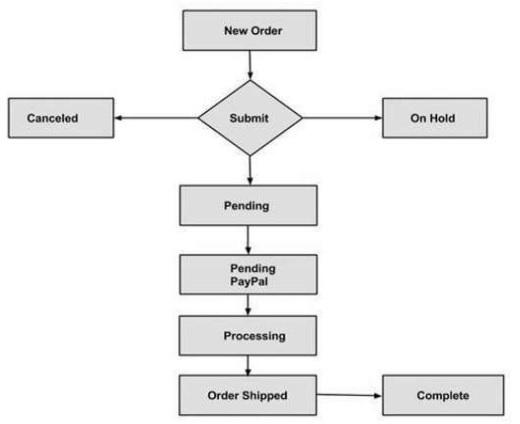
New Order − Customer places an order into the Magento store.
Pending − Pending orders are brand new orders that have not been processed. These orders need to be invoiced and shipped.
Pending PayPal − These are the brand new orders that have been not cleared by PayPal.
Processing − When you invoice the order, Magento will change the state to 'processing'.
Cancelled − This status is called when the customer visits the store and cancels an order or else if the order has been not paid for.
Order Shipped − Order shipment is generated when an order status changes from pending to complete.
On Hold − Order is put on hold when more information from the user is required before the purchase is processed.
Complete − When order is marked as complete, it has been both invoiced and shipped.
The following steps describe how Magento order life cycle works −
Step 1 − Login to your Magento Admin Panel.
Step 2 − Go to Sales menu and click on the Orders option.

Step 3 − Next, you can see some orders list. Click on the View link to see the order's information.

Step 4 − You will see the customer's account information and billing address. When you scroll down, you will see the history status under the Comments History section.

Step 5 − Click on Track and scroll down to the lower portion of the page. Under the Items table, go to Track column which provides tracking options like Backordered, Recieved or Returned when you click on the dropdown menu. Select your option and click on the Submit Changes button to save your settings.
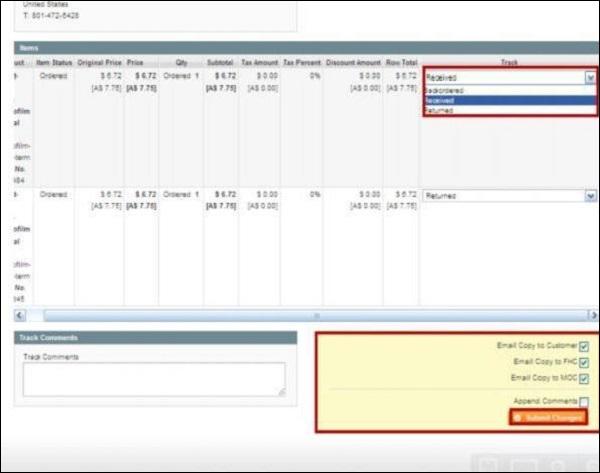
Magento - Setup Order Options
Magento provides various options for product orders and also reports of the ordered products.
Step 1 − Login to your Magento Admin Panel.
Step 2 − Go to Report menu and click on Orders under Sales option.

Step 3 − The Total Ordered Report has some settings as shown in the following screen.

Match Period To − It matches the product ordered date with order created data and updated date.
Period − It specifies the period such as day, year and month.
From and To − These options display the date of order, i.e. they specify the date on which the order was created date and the date up to which it is valid.
Order Status − It specifies the status of the order.
Empty Rows − If you don’t want to specify empty rows, then set Empty Rows field to No.
Show Actual Values − If you don’t want to display actual values of product, then set the field to No.
Step 4 − You can get a report of the order by clicking on the Show Report button and you can also save your ordered details in the CSV file format by clicking on the Export button.

Magento - Setup Order Emails
This chapter describes how Magento manages e-mails, how you can edit e-mail content, set e-mails from and to parameters, etc. Magento has built-in functionality called Sales Emails which manages the e-mails sent to customers when the order is processed.
The following steps describe how to set up order e-mails in Magento −
Step 1 − Login to your Magento Admin Panel.
Step 2 − Go to the System menu and click on Configuration option.

Step 3 − On the left side of the navigation bar, go to Sales section and click on the Sales Emails option.

Step 4 − Select the scope under Current Configuration Scope for which you want this configuration to apply.

Step 5 − Under Sales Emails page, expand the Order panel which contains the following settings.

Enabled − Set this option to Yes to enable new order confirmation e-mails to be sent.
New Order Confirmation Email Sender − Using this field, select the e-mail address which is to be used for sending new order confirmation.
New Order Confirmation Template − It selects the template which is to be used for the order confirmation e-mails, sent to the registered customers.
New Order Confirmation Template for Guest − It selects the template which is to be used for the order confirmation e-mails, sent to the guest customers.
Send Order Email Copy To − It specifies the e-mail address to which copy of the new order confirmation e-mail is sent.
Send Order Email Copy Method − You can send copy of the new order confirmation e-mail to the additional e-mail address using BCC or separate e-mail.
Step 6 − After done with the settings, click on the Save Config button to save your changes.
Magento - Create Orders
Magento allows to create an order from a shopping cart. You can create an order in Magento store as described in the following steps.
Step 1 − Login to your Magento Admin Panel
Step 2 − Go to Sales menu and click on the Orders option.

Step 3 − Click on the Create New Order button to create new order in the Magento store.

Step 4 − It will display the list of customers under New Order section. If there are no records, then click on Create New Customer button.

Step 5 − Moving forward, you need to select your desired store to precede to the next step.

Step 6 − Under Items Ordered section, it will display the ordered products information. If there are no ordered items, then click on the Add Products button to select the product which you want to order.

Step 7 − Select the product from the list which you want to order and click on the Add Selected Product(s) to Order button.

Step 8 − Scroll down and select the Payment Method and Shipping Method for your order.

Step 9 − After selecting your payment method and shipping method, click on the Submit Order button to save your order.

Step 10 − To see the status of the order, go to Sales menu and click on the Orders option. To see the details of the product, click on the View link as shown in the following screen.

Step 11 − Now you can see the account information and billing address of the customer. Scroll down, you will see the status of the product and comment area under the Comments History column.

Magento - Manage Orders
Order management is an important process which allows businesses to run smoothly and keeps customers happy, making them more likely to visit your site again in the future. When the customer completes the order process, you will receive a new order notification mail.
The following steps describe how to manage orders in Magento −
Step 1 − Login to your Magento Admin Panel.
Step 2 − Go to Sales menu and click on the Orders option.

Step 3 − It will display the list of orders placed in the store. Click on any of the orders.

Step 4 − Next, it will show the order form. It includes information regarding the order such as the account information and billing address of the customer, payment information, status of the product and comment area under the Comments History column, etc.

Step 5 − You can see the e-mail has been sent to the customer regarding the product order. Create the invoice for the order and alert the customer that the order is accepted by clicking on the Invoice button.

Step 6 − Scroll down the invoice page and click on the Submit Invoice button.
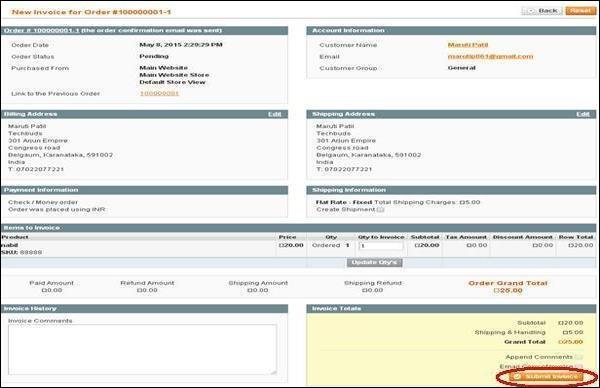
Step 7 − Now the order will get processed and gets accepted into the system. Alert the customer about the product order by sending an e-mail. Type your comment in the text area and click on the Submit Comment button.

Step 8 − The product is shipped and you need to update the customer on their order status. Enter the completed order into the system and notify the customer regarding shipping of your product by clicking on the Ship button.

Step 9 − Under Shipping Information section, click on the Add Tracking Number button and choose your Carrier from the dropdown menu and put the tracking number of your order and click on the Submit Shipment button.

Step 10 − It will notify the customer regarding status of the product shipping. Type your comments and click on the Submit Comment button to notify the customer.

Magento - Setup Customers
It is necessary to record customer accounts and customer registration process in Magento. This chapter describes the customer settings as shown in the following steps.
Step 1 − Login to your Magento Admin Panel.
Step 2 − Go to System menu and click on the Configuration option.

Step 3 − Click on the Customer Configuration option under CUSTOMERS section on the left side navigation bar.

Step 4 − Expand the Account Sharing Options panel which includes the field Share Customer Accounts that is set to Per Website value. This determines that customers can use this account to login only on particular website. Next, expand the Online Customers Options panel and set the interval time for Online Minutes Interval option. By default, it is empty and value is set to 15 minutes.

Step 5 − The Create New Account Options panel contains following fields. Fill up all the fields as provided in the screen and click on Save Config button to save your changes.

Step 6 − The Password Options panel has some settings −

Forgot Email Template − It helps to reset the customer's password, if the customer’s forgot their password.
Remind Email Template − It changes the template for particular e-mail transaction.
Forgot and Remind Email Sender − It selects an e-mail address which sends password message to the customer which are displayed from the fields of Forgot and Remind mail Template.
Recovery Link Expiration Period − It specifies for how many days the recovery link will be active for resetting password.
Step 7 − The Login Options panel has an option called Redirect Customer to Account Dashboard after Logging in which is set to Yes by default. If you set it to No, customers will stay on the current page. After done with the settings, click on the Save Config button to save your changes.
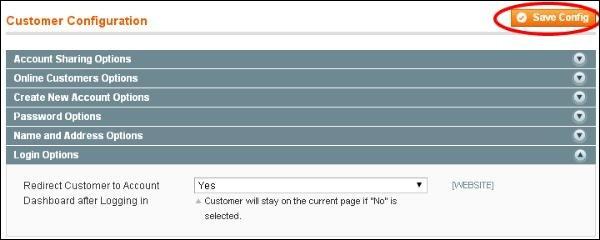
Magento - Setup Google Analytics
Google Analytics, is Google’s web analytics service for those who are actively managing websites. It adds analytics to Magento store including E-commerce tracking and conversions of their websites. It allows administrators to monitor their website's traffic.
The following steps help you set up Google Analytics in Magento store −
Step 1 − Login to your Magento Admin Panel.
Step 2 − Go to the System menu and click on the Configuration option.

Step 3 − On the left side of the navigation bar, click on the Goggle API option under Sales section.

Step 4 − Expand the Google Analytics panel which shows some settings such as −
Enable option should be set to Yes to activate payment method
Type option provides two types: Google Analytics and Universal Analytics
Account Number accepts your account number
Enable IP anonymization option should be set to Yes.
After done with the settings, click on the Save Config button to save the changes that you have made.

Magento - Setup URLs
You can use Magento to build for more user and search engine friendly URLs as shown in the following steps.
Step 1 − Login to your Magento Admin Panel.
Step 2 − Go to System menu and click on the Configuration option.
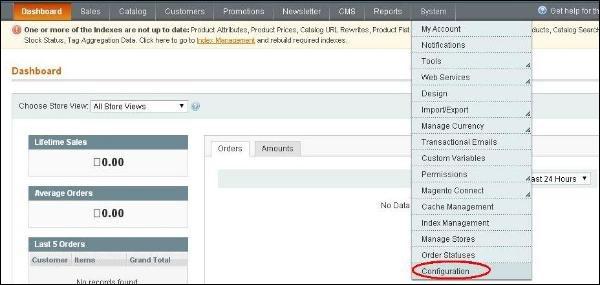
Step 3 − On the left side navigation bar, click on the Web option under General section.

Step 4 − When page loads, expand the Search Engines Optimization option. Set the option Use Web Server Rewrites to Yes to enable the Search Engine Friendly (SEF) URLs in Magento. If you select the option as No, then Magento will not use SEF URLs. Click on the Save Config button and your Magento SEF URLs will be enabled.

Magento - Setup Youtube Video
In this chapter, we will learn how to set up YouTube videos to your Magento store as shown in the following steps.
Step 1 − Login to Magento Admin Panel.
Step 2 − Go to CMS menu and click on Pages option.

Step 3 − You will get the list of pages where you can create a new page or edit an existing page. Here we have selected the About Us page to add YouTube video in it.

Step 4 − On the left menu, click on the Content option which displays the information of the page. The Show/Hide Editor button can be used to hide or show the editor.

Step 5 − Open the www.youtube.com website and find the video you want to add. There is a Share button under the video, click on it.

Step 6 − Under the Share button, click on the embed link. It opens a small text area, then copy the code.

Step 7 Go to your page and paste the code which was copied from the embed field and click on the Save Page button.
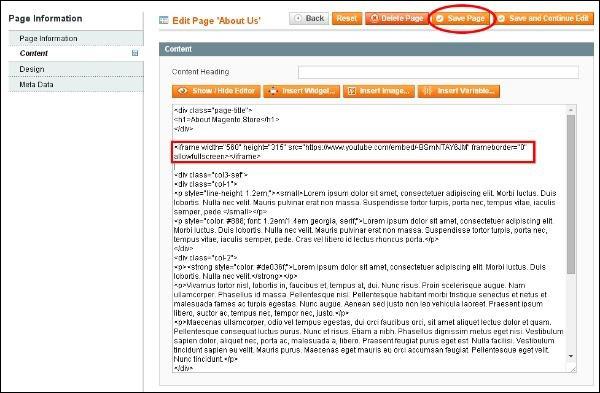
Step 8 − Open your website and you can see the video on the page you just edited.

Magento - Setup Facebook Likes
Social networks such as Facebook, Twitter and Google Plus have become powerful for promoting the web shops. Facebook provides "Like" button which allows users to share contents of the products across the web.
The following steps show you how to add Facebook Like button for your Magento products −
Step 1 − Go to developer site of Facebook https://developers.facebook.com/docs/plugins/like-button and click on Get Code button.
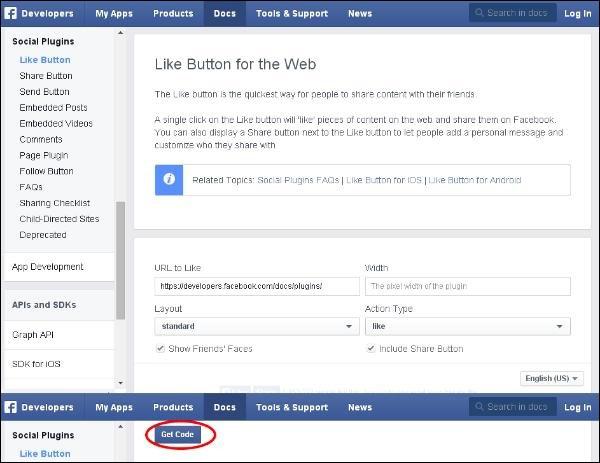
Step 2 − When you click on the Get Code button, a window will get appear as shown in the following screen.

Step 3 − Open the file i.e. /app/design/frontend/base/default/template/productalert/product/view.phtml in the Magento and paste the below code around the line 50.
<div class = "fb-like" data-href = "https://developers.facebook.com/docs/plugins/"
data-layout = "standard" data-action = "like" data-show-faces = "true"
data-share = "true">
</div>
Step 4 − Go to the System menu and click on the Cache Management to refresh the cache.

Step 5 − Under Cache Storage Management section, select the items from the Cache Type column for which you need to refresh the cache. Select the Refresh option from the Actions field on the right hand corner and click on Submit button to refresh the cache.
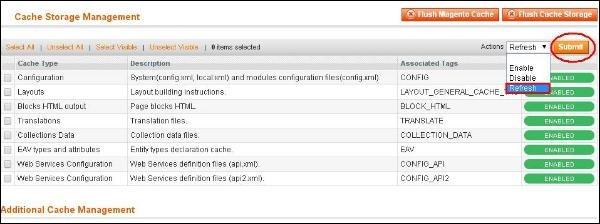
Step 6 − After refreshing cache, logout from your admin panel and re-login. Refresh your product view page to see the Facebook like button.
Magento - Setup Translation
You can translate Magento default frontend through csv file as specified below −
Look into your (root)/app/locale/en_US folder. There you have .csv's that do the translating. The Mage_Catalog.csv contains the translations for all the files that use the /app/code/core/Mage/Catalog/classes and /app/design/frontend/default/default/locale/en_US/translate.csv template files. Here, you'll also find Mage_Adminhtml.csv, which handles most of the admin translations.
If Magento translation fails, you should check the settings for store in admin panel, to see if there is something wrong with your locale.
On the Magento Admin Panel, go to System menu and click on the Configuration option.
Select the Configuration Scope of the store view in the upper left corner.
On the General configuration page, expand the Locale Options section.
Under Locale Options, set Locale to the new language for the store view and click the Save Config button.

Magento - Setup System Theme
This chapter describes how to install new Magento theme on your store's frontend. You can use Magento Connect to install theme. For installing theme, you need to get the extension key and then use it for the installation through Magento Connect.
We will see how to get extension key by using the Magento theme −
Step 1 − Go to Magento theme page and then click on the Install Now button. You need to register a new account or login with an existing account to get extension key.

Step 2 − Check, I Agree to the Extension license agreement option and click on the Get Extension Key button.

Step 3 − Click the Select Key button and copy the extension key.

Step 4 − Now login to your Magento Admin Panel and go to the System → Magento Connect → Magento Connect Manager option.

Step 5 − Again, it will ask for login, enter your credentials to redirect to Magento Connect Manager window.
Step 6 − Now under Extensions section, paste the Extension Key (that you copied in step 2 and click on Install button. It will display status as "Ready to install" and click on Proceed button to install the language.
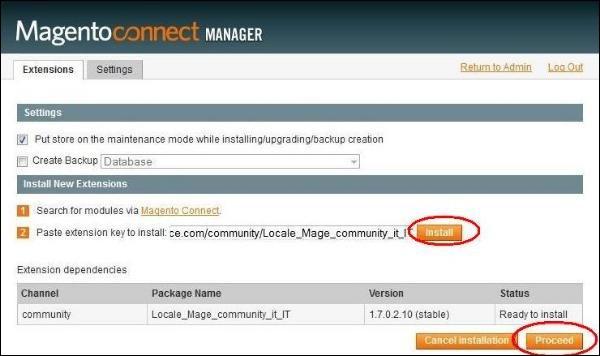
Step 7 − It will check for dependencies of packages and display the message as Cache cleaned successfully.

Step 8 − Refresh the page by clicking on the Refresh button and go to an admin dashboard page by clicking on Return to Admin link.

Step 9 − To activate the theme on your store's frontend, go to System menu and click on the Design option.

Step 10 − To add a new theme, click on the Add Design Change button.

Step 11 − Select the theme from the Custom Design dropdown menu and click the Save button to apply your theme for the store.

Magento - Setup Page Title
Magento allows changing the default title of your website. The following steps describe how to change the title of Magento store.
Step 1 − Login to your Magento Admin Panel.
Step 2 − Go to the System menu, click on the Configuration option and select the Design option under the General section.

Step 3 − Expand the HTML Head panel and you can edit the title in Default Title field. After done with the settings, click on the Save Config button.

Magento - Setup Page Layout
Layout files are useful in rendering front pages of Magento. Using Magento, it's easy to change the layout of pages.
This chapter describes how to create page layout in Magento −
Step 1 − Login to your Magento Admin Panel.
Step 2 − Go to CMS menu and click on the Pages option to list out all the pages of Magento. Select the page which you want to change the layout.

Step 3 − Click on the Preview button to see structure of the page.

Step 4 − To see the layout of the page, click on the 3 columns option under Layout tab. It will open the Page Information section. Click on the Design option. Select the option as per your choice in the Layout field and click the Save Page button to apply the changes.

Step 5 − When you click on the Preview link, it will display the changed layout of the page.


Magento - Setup New Pages
This chapter shows how to create new pages in Magento by using the following steps −
Step 1 − Login to your Magento Admin Panel.
Step 2 − Go to CMS menu and click on the Pages option.

Step 3 − It will list some of the existing pages as shown in the following screen. If you want to add new page, click on the Add New Page button.

Step 4 − Next, specify the title for the page using Page Title field, enter the page URL identifier using URL Key option. Enable the page using Status dropdown menu and click on the Save and Continue Edit button.

Step 5 − When you save the page, it will go to Content section asking heading for the page using Content Heading field and page content. Click on Save and Continue Edit button to proceed to the next step.

Step 6 − After done with the content section, you can design the page by using Design section which has two sections i.e. Page Layout and Custom Design.
The Page Layout section contains a Layout option which allows select a layout as per your choice and Layout Update XML option inserts the XML code.

The Custom Design section contains fields such as −
Custom Design From and Custom Design To are used to set start date and end date for the design change
Custom Theme option allows to select theme for your page using dropdown menu
Custom Layout option allows to select a layout as per your choice
Custom Layout Update XML option inserts custom XML code

Step 7 − The Meta Data section contains Keywords field which sets keyword for a page name and the Description field specifies the description the given page. Click the Save Page button to save your page.

Step 8 − Now you can see the page created in the list.

Magento - Setup CMS
Magento CMS (Content Management System) section is used to manage all website pages. It is a way of promoting the products by providing valuable information to the customers and increases search engine visibility. It can be used to create rich content for your web store.
The CMS section contains following topics −
Pages
You can create or setup new pages in Magento. You can include text, images, blocks of content etc. For more information on setting up new pages, you can refer this link Setting up New Pages.
Static Blocks
Static block is a piece of content that can be used anywhere in the pages. Magento allows creating blocks of content that can be used through the store and can be added to any page or another block. To create static blocks, follow these steps −
Step 1 − Go to CMS menu and click on the Static Blocks option.

Step 2 − You can create a new block by clicking on the Add New Block button.

Step 3 − Next, it will open a window for creating new block as shown in the following screen.

The page contains the following fields −
Block Title − It adds the title for the block.
Identifier − It assigns identifier to block which uses lower case characters, underscores, etc.
Status − Set this field as "Enabled" to make block visible.
Content − It includes content of the block and uses editor to format text, creates links, tables, images, etc.
After filling the all fields, click the Save Block button.
Widgets
Widget allows displaying a wide range of content and placing it at block references in the store. They can be inserted into pages, blocks or they can have blocks inserted into the widget.
You can create the widget by using following steps −
Step 1 − Go to CMS menu and click on the Widgets option.

Step 2 − To create new widget, click the Add New Widget Instance button.

Step 3 − Under the settings section, select the Type of the widget and Design Package/Theme and click the Continue button.

Step 4 − Next, it displays the Frontend Properties and Layout Updates sections.

In the Frontend Properties section, fill the following details −
Widget Instance Title − It specifies the title for the widget. It is only for internal use and won't be visible to the customers.
Sort Order − It is used to specify the order of the block when listed with others.
In the Layout Updates section, click the Add Layout Update button and set the Display On field to type of category where you want the widget to appear. It can be set with the other options as shown in the following screen.

In the Block Reference list, select the section of your page layout where you want the widget to appear and set the template with Link Block Template or Inline Template.
Step 5 − Click Save and Continue Edit button to save your changes and continue editing. Next, it will open Widget Options panel with the following options.

Anchor Custom Text − It adds custom text for the widget.
Anchor Custom Title − It adds custom title for the widget.
CMS Page − It allows selecting the CMS page with the widget.
After done with the settings, click on the Save button.
Polls
Polls are used to get customer's opinions and preferences. The poll results appear immediately after response is submitted.
You can create the poll by using the following steps −
Step 1 − Go to CMS menu and click on the Polls option.

Step 2 − Next, it will open a Poll Manager window where you can add new poll as shown in the following image.

Step 3 − In the Poll Information section, enter the Poll Question and you can set the Status to "Open" or "Closed".

Step 4 − In the Poll Answers section, do the following −

In the Answer Title field, enter the answer as you want it to appear in the poll for which you had entered the poll question and to weight an answer, enter a number in the Votes Count field. When complete, click the Save Poll button.
Magento - Setup Newsletter
Creating newsletter is a part of communication process with the buyers. Customers can subscribe to newsletters using Magento. Customers can sign up for the newsletter while creating a new customer account which contains checkbox for sign up. For creating newsletters, you need to enable newsletter option in your Magento to make sure that customers have confirmed to receive newsletter.
Step 1 − To enable newsletter, go to System → Configuration and click on Advanced option under Advanced section on the left side navigation bar.

Step 2 − Expand the Disable Modules Output panel, look for Mage_Newsletter option and Enable it.

You can configure the newsletter settings as described in the following steps −
Step 1 − Login to your Magento Admin Panel.
Step 2 − Go to System menu and click on the Configuration option.

Step 3 − On the left side navigation bar, go to Customer section and click on the Newsletter option.

Step 4 − Then, expand the Subscription Options panel, select the Yes option for Need to Confirm field. Yes option specifies that customers want to subscribe to newsletter. Click on the Save Config button to save your changes.

Creating Newsletter Template
Before sending a Newsletter, you need to create a newsletter template. To create a newsletter template, follow these steps −
Step 1 − Login to your Magento Admin Panel.
Step 2 − Go to Newsletter → Newsletter Templates and click on the Add New Template button.

Step 3 − It will display some settings related to newsletter template. Fill up all the necessary fields and click on the Save Template button as shown in the following screen.

Template Name − It is the name for your template.
Template Subject − It specifies the subject of the e-mail which would be received by the customer.
Sender Name and Sender Email − These fields specify the name and e-mail of the sender which is to be sent to customers.
Template Content − It provides text editor and allows entering HTML code of the body of the e-mail.
Send Newsletter
You can send the newsletters to your subscribers by queuing the template as shown in the following steps.
Step 1 − Go to Newsletter menu and click on the Newsletter Queue option which displays the newsletter templates.

Step 2 − For sending the Newsletter to subscriber, go to Newsletter → Newsletter Templates and select the Queue Newsletter option from the dropdown menu on the bottom right side of Newsletter Template page.

Step 3 − The page that pops up provides some of the options as shown in the following screen.
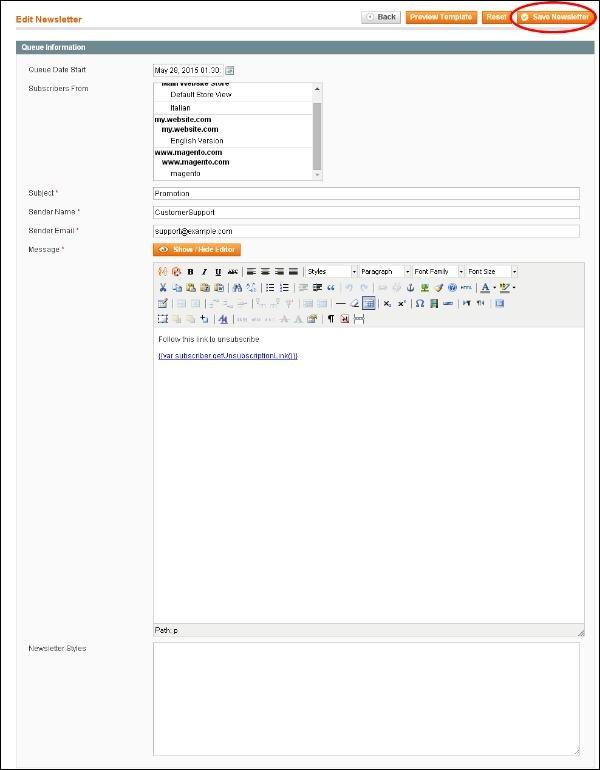
Queue Date Start − It selects the date when you are going to start sending the newsletter.
Subscribers From − It shows both former and current subscribers list.
Subject − It specifies the subject of the e-mail.
Sender Name and Sender Email − These fields specify the name and e-mail of the sender which is to be sent to customers.
Message − It provides text editor and allows entering message of the e-mail.
Fill up all the fields and click on Save Newsletter button on the top right corner to send newsletter to subscribers.
Magento - Site Optimization
Magento is a content management system that is commonly known to be performance intensive. Optimizing the speed of your Magento allows customers to have the best user experience while shopping in your E-commerce store.
Environment Optimization
Based on the additional configurations of the server environment, the hosting site providers speed up your store.
Following are the tips to optimize Magento environment.
It uses complex database, so that it needs to be run on dedicated servers.
Magento application can be optimized by using cloud computing.
Merge your JavaScript and CSS files, which reduces the load time dramatically since it is loading only one merged file.
Proper MySQL configuration is one of the most important aspects in terms of performance.
Always upgrade to the latest Magento version as it offers better performance.
Use a web application accelerator which can speed up your Magento store by 80%.
Configuration Optimization
Magento has built-in tools that helps to optimize its performance. These must be properly configured and matched with your site's unique requirements. Following are the tips to optimize Magento configuration.
To speed up Magento performance, don't run MySQL and web server on the same machine.
Do not host files on your web server that you do not use.
Optimize of session storage.
Enable Magento flat catalog. (Magento uses a complex and resource-intensive Entity Attribute Value [or EAV] based catalog). After initial catalog establishment, enabling the flat catalog can dramatically improve database query time.
Identify and disable unused Magento modules.
Code Optimization
Code influences the speed of your site. The testing tools help to gain insight into the specific process.
Few tips for Code Optimization are −
Remove unused or unnecessary code processes.
Optimize Magento performance, by compressing and aggregating JavaScript and CSS files.
Compress all site images to optimal web image sizes.
Identify bottlenecks (processes that causes the entire process to slow down or stop) both in front-end and back-end.
Frontend Optimization
These modules are used to improve the performance of Magento shopping experience and you can also reuse the modules. This speeds up the performance of the Magento front-end.
The following points illustrate how to optimize Magento front-end performance −
Use the latest version of PHP, so that you can perform front-end operation much better and faster. The newest released version may cause errors, so carefully read the release notes and check out the new version.
Use clean database to improve the performance of Magento. The database logs needs to be cleared regularly. The database stores the automatically created logs to keep track of record session and interaction.
Magento caching should be enabled. This helps to load your website faster and reduces the direct requests to the server for files.
Turn off unused modules so it reduces the amount of resources added to each page. This can be one of the Magento admin panel. The XML files are used to speed up the front-end performance of Magento.
Magento - Profiling
The feature called Profiler which plays an important role in Magento development and can be used for debugging. It specifies blocks of code which makes loading of the page slow. Magento profiler reports the time taken by block of code to execute, number of times the block of the code was executed and memory used by it while rendering a Magento web page.
To enable the Profiler, follow these steps −
Step 1 − Login to your Magento Admin Panel.
Step 2 − Go to System menu and click on the Configuration option.

Step 3 − On the left side of the navigation bar, go to Advanced section and click on the Developer option.

Step 4 − Expand the Debug panel and enable the profiler by setting it to Yes and click on the Save Config button.

Step 5 − At this point the profiler is enabled, but you need to tell the profiler to what profile. So go to root index.php file of your Magento installation and look for the line #Varien_Profiler::enable(); and uncomment it, i.e. remove the hash sign.
Step 6 − Now go to any of your pages, you should see the output in the footer area of the page like shown in the following screen.

Magento - Database Performance
One of the most time consuming process of the Magento store is its interaction with the database. Optimizing Magento Database is an important task to maintain the Magento site. Magento saves a lot of database because of tracking. The E-commerce system must have a tracking module which shows information when something goes wrong with their order.
Following are some tips to improve the performance of database −
Unused data must be cleaned up regularly for better performance.
Optimize database queries.
Configure setting and limits of the database server (e.g. memory setting, query cache, sort buffer optimization).
You can optimize Magento database log cleaning as shown in the following steps −
Step 1 − Login to your Magento Admin Panel.
Step 2 − Go to System menu and click on the Configuration option.
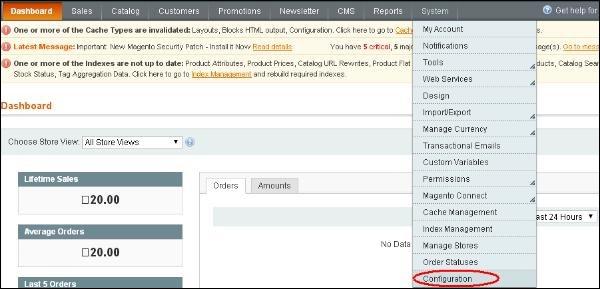
Step 3 − On the left side of the navigation bar, go to Advanced section and click on the System option.
Step 4 − Expand the Log Cleaning panel, change "Enable Log Cleaning" to Yes option and click the Save Config button.
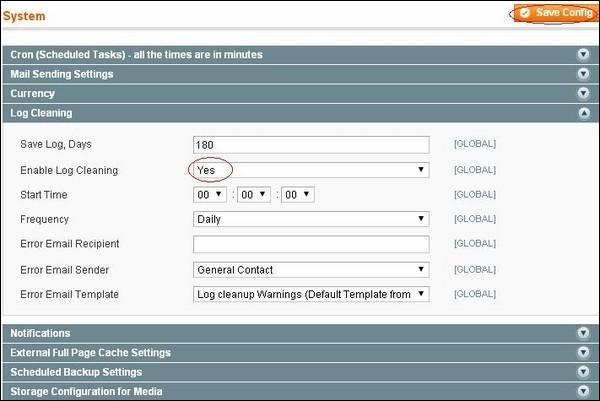
Magento - Search Engine Optimization
Magento is one of the search engine friendly systems. It is an essential component of a running web-based business and important form of marketing online. To make e-store more visible to the potential buyers, the website admin needs to enhance e-store ranking in search engine results. Customers will like your site if your site is clean, clear and easy to navigate.
Magento allows managing URLs, creating images and handling links that makes easy use of SEO, so that your site can easily be indexed in search engines. After installing Magento and setting up your store, you can start optimizing your site for search engines from the web configuration menu.
The following steps describe how to set up Search Engine Optimization (SEO) in Magento −
Step 1 − Login to your Magento Admin Panel.
Step 2 − Go to the System menu and click on Configuration option.

Step 3 − On the left side of the navigation, go to the General section and click on the Web option.
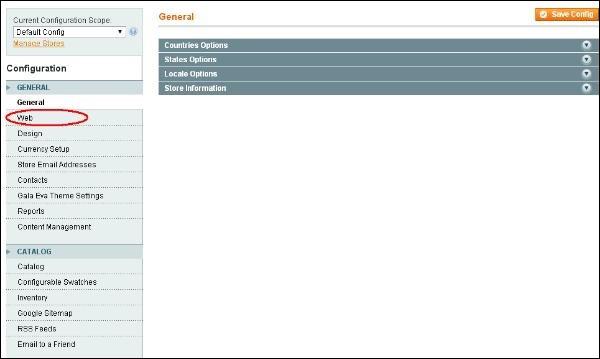
Step 4 − Expand the URL Options panel, set the Add Store Code to URLs option to No so that store codes are not added to URLs.
Step 5 − In the Search Engine Optimization panel, set the Use Web Server Rewrites option to Yes to generate more search engine friendly and readable URLs. Click on Save Config button to save your changes.
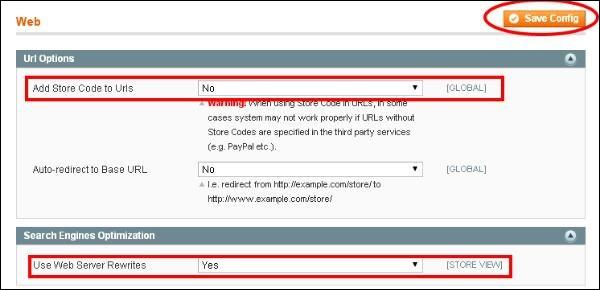
Step 6 − To set the default page title, change setting of default robots, go to System → Configuration and under General section and click on the Design option.

Step 7 − Expand the HTML Head panel, write the title and description in the Default Title and Default Description for your pages, change the Default Robots field to INDEX, FOLLOW option so that search engines can index your website and show it in search results. When you are done, click Save Config button.

Step 8 − To avoid duplications in URLs, go to the System → Configuration and under Catalog section, click on the Catalog option.

Step 9 − Expand the Search Engine Optimizations option and set the Use Categories Path for Product URLs option to No. To prevent Magento from generating duplicate content when you want to show the same product in multiple categories, set both Canonical Link Meta Tag fields to Yes. After done with the settings, click the Save Config button.



































































































































































































































